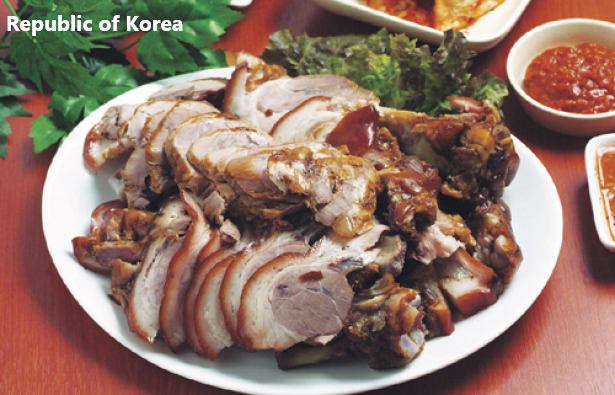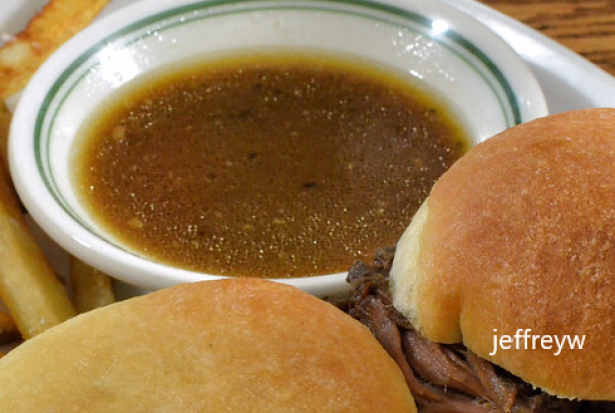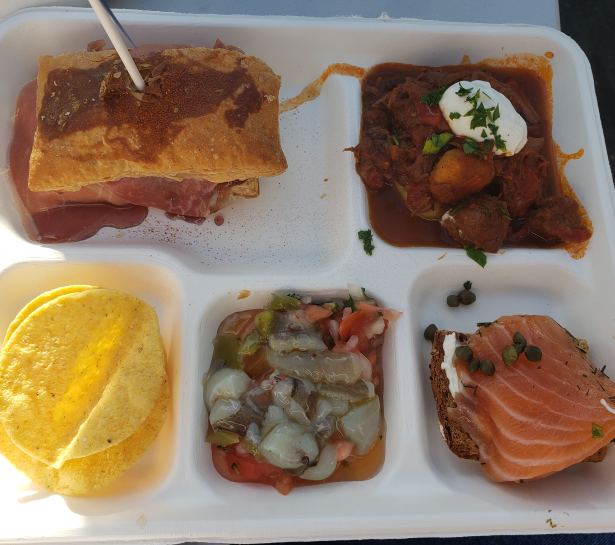QT 114 – A Drink or Two, and Anju

Why hello there, and welcome back to Kitchen Catastrophe, where we’re pounding down flagons of FACTS to sate our endless thirst for Knowledge. I’m your Quizzical Quaffer, Jon O’Guin, and today, we’re going to talk about Korean anju, drink pairings, and the informal American system.
So, on Monday, I referred to anju as “Korean Bar Food”, and that’s…it’s not WRONG, but it fails to capture some of the spirit of it. Specifically, you should note that it’s considered a little uncouth to NOT have anju with drinks. Koreans really take “never drink on an empty stomach” seriously. Now, anju can be as small as “a handful of nuts and/or fruit”, so it’s not like this is particularly onerous, but it’s worth noting.
Oh no, you mean it’s rude for me to NOT have spicy fried chicken while drinking? Truly a sacrifice.
Secondly, there’s a system to anju, where certain dishes are recommended for specific types of drinks, much in the way that say, Americans understand wine or beer pairings. In Korea, Fried chicken goes with beer the same way that fish goes with white wine here. Here’s a quick run-down of the categories, and their pairings.
Soju
Soju, Korean “rice” alcohol, used to be the premiere drink of Korean night-life, and is still very common at bigger dinners. I specified ‘alcohol’ because Soju has a BIG range of alcohol contents: at its lower end, it’s roughly comparable to a wine, but it can be distilled to hard alcohol status. (its name means “burned wine/alcoholic drink”, supposedly referring to the boiling and distilling process, not like, flambé shenanigans, but maybe refers to the burn of the alcohol) I also said “rice” in quotations, because rice is to soju as potatoes are to vodka: they’re the most commonly associated source, but by no means the only one. You can make potato soju, just like you can make corn vodka. Starches breakdown into alcohols pretty easily, and once you’ve distilled them enough, the differences are fairly negligible. Hell, one of the old names FOR VODKA was “burning wine”.
Soju is, in some ways, probably easiest TO compare to vodka, not just because they had the same name, but because it also comes in a wide variety of flavors, often fruit-based. To match the strong alcohol, the conventional wisdom is you want spicy and hearty food. This is the drink you’d serve with spicy jjigae, or (and these are real examples) grilled cow stomach, pork intestines, or pig trotters.
In their defense, pig trotter doesn’t LOOK weird when cut up for service.
You get some conflicting reports on whether you’d have kimchi pancakes with this drink or the next one, probably due to the range in spiciness of kimchi, and people using the lower ABV versions of Soju. Or maybe just because people inevitably feel like drinking based rules are fine to bend every now and again.
Makgeolli
Makgeolli is a somewhat hard to explain Korean drink. Perhaps the best context for it is to explain that its name can best be translated as “poorly strained”. It’s a low-alcohol rice wine with sediment in it that creates a milky appearance. If you know about beer, you might be familiar with saisons, a type of cloudy ‘farmhouse ale’. This is the rice-wine version of that. For those unfamiliar with saisons, congratulations on not being a hipster like me and the rest of the group, and it’s maybe best explained by the context of usage: Makgeolli is the go-to drink with all kinds of fried pancakes, like kimchi-jeon, haemul-jeon (seafood pancakes), and many others, because the two are thought to pair well together, and are the Korean “rainy-day” food. Supposedly, this is either because of association (the hiss and spatter of frying pancakes sounding like rain falling on a roof), or because makgeolli, as a rustic farmhouse kind of alcohol, would be the kind of drink consumed by farmers on days where the rain prevented them from tending to their crops, and pancakes were an economical food option.
“Well, time for me to eat fried dough and drink cloudy wine”.
The drink is also noted for being mildly astringent, so I think of it as “cloudy-beer-wine-tea”. I also try not to think of it often, because that’s a hard concept to hold all at once. If not paired with a pancake, most of the other pairings are ‘chewy’ dishes like snail salad, buckwheat noodles, or stir-fried tofu or chicken. And Raw oysters, for some reason.
Cheongju
Cheongju is much easier to explain, which is why this will be the smallest section, since it’s basically just Korean Sake. Cheongju literally means “clear wine”, as compared to makgeolli, which is a takju or “cloudy wine”. Cheongju has a bunch of flavored variants like Soju, typically called “X-ju”, since Ju means “wine/alcoholic drink”.
Meanwhile, when I say “ju” in reference to a liquid, it’s because I forgot a letter from au jus, and I’m talking about beef.
Cheongju is paired with grilled meats, traditional Korean candies, namul (seasoned vegetables. You remember the three different types of veggies I made for Bibimbap? Those are ALL namul), and the Korean version of Beef tartare, as well as the Korean version of sashimi, saengseon-hoe.
Beer
Korean beer (maekju) is another growing drinking option, especially as Korean governmental agencies try to change some of the customs around drinking: drinking is HUGE in Korea, where the average Korean has about 11 shots per week, more than twice the Russian average. This is because many jobs view drinking with one’s colleagues as an important team-building/idea-sharing time. You will sometimes have to answer questions about your drinking habits, or even TAKE SHOTS at job interviews, so the company can assess if you can handle your alcohol and if your personality will fit in. It’s not uncommon for many non-retired Koreans to go out twice a week, once to drink with work colleagues, and once with friends/family, and in both instances, the average number of drinks per trips is around 5 shots. (And can I just say, the idea of a older Korean businessman pounding shots is adorable?)
Like this, but with a suit, and less make-up.
To put an immediate whiplash from that adorable image, this tradition has led to a BUNCH of drinking-related illnesses, including liver cancer and freaking osteonecrosis (“bone rot”) so the government is trying to move people to less intense forms of drinking, or at least less-shootable types of drinks, like beer. Helping with this process is chimaek, a portmanteau of chikin (as in “chicken”. They have their own word for it, but they like using ours.) and maekju, “beer”: During the Korea-Japan World Cup face-off, chimaek became huge, with thousands of Koreans gathering in public squares to watch big-screen projections of the match, drinking beer and eating fried chicken. It also became popular in China over the last 7 years, because…okay, this is a doozy: A 2013/2014 Korean Drama about an immortal alien hiding among humanity falling in love with an actress mere months before he is able to return to his people, “My Love from The Star”, really caught on with Chinese audiences, and has a scene where the female lead pronounces that “snowy weather is the perfect time for chimaek”, and then proceed to eat fried chicken and drink beer, starting a trend to imitate her.
In their defense, I too aspire to eat chicken with this degree of indifference.
In fact, Korean beer-drinking culture is probably the most accessible to Americans: common pairings are the aforementioned fried chicken, Pizza, other fried dishes, yukpo aka “Korean Beef Jerky”, corn-cheese (a Korean side dish of…melted mozzarella and corn. That’s it. That’s the dish.), and nuts or sausage. Oh, and tteokbokki. Which is fascinating to me, since tteokbokki is so chewy (implying it might end up in the makgeolli pairing) and normally quite spicy, implying a soju pairing. But no, it’s apparently with beer. (I think it’s just that tteokbokki is cheap and easy, and beer is cheap and easy.)
A Shot For the Road
And boom, that’s the basics of Anju, and some rough sketches of Korean drinking culture as a whole. You might think it seems a little formal or complicated, but when you really think about it, it’s not too different from how we in America think of wine pairings, and how we even have certain specific match-ups. Most bar food is fried, or salty, partly to prompt people to drink more, but also because that just goes well with beer, or cocktails built on soda. Whiskey is often paired with cigars specifically because of the peat notes and smokiness of the drink, with “tobacco” being a fairly common tasting note for Scotches. I’ve had breweries hand me guides suggesting what beers go well with which meals, and I’ve even been to a Beer-Pairing Tasting menu, where over 5 course, you paired different beers from a brewery with specific dishes that highlighted/balanced the flavor profile.
There was perhaps a little too much raw octopus in the tasting menu for my preference, but to each their own.
And the process DOES work, in that, as so much of taste is bound up in aroma, and different compounds can interact in certain ways, you will get different effects and flavors pairing different dishes together. It is, however, a complicated business, and one somewhat shaped by belief and custom.
This is big enough for its own post, but the science of wine-tasting is VERY complicated, and often considered to be more than a little…wobbly. It is VERY easy to trick wine-tasters: the same wine can be presented as expensive or cheap, or Red or White (with the help of food coloring), and will change how people assess It and discuss its notes, with most being fooled. Statistical analysis of wine-judging at various competitions suggests that many tasters are operating functionally at random, with the same wine being rated from “acceptable” to “excellent” by the same taster over the course of a day, intermingled with other wines. Still, there is some kind of consistency: A Princeton economist showed that, if you know the weather conditions of a given Bordeaux’s harvest year, and its chateau, you can reliably predict both its price and the rating it will get.
And with that consistency comes some things that most people do agree on: Red wine goes with beef fairly well, while white wine does well with fish. This is just a broader version of the same idea, adapted to a different set of standard alcohols. So regardless of where you are or what you’re drinking, cheers, and bottom’s up!
MONDAY: YOU THINK I’D HAVE COME UP WITH SOMETHING IN THE TWO DAYS I HAD. UNFORTUNATELY, YOU’D BE WRONG. MAYBE SOMETHING VEGAN? OR A DRINK? IT’S BEEN LIKE, OVER A YEAR SINCE I MADE A COCKTAIL FOR THE SITE.
THURSDAY: WE’LL KNOW WHEN WE HAVE MONDAY HAMMERED OUT.












